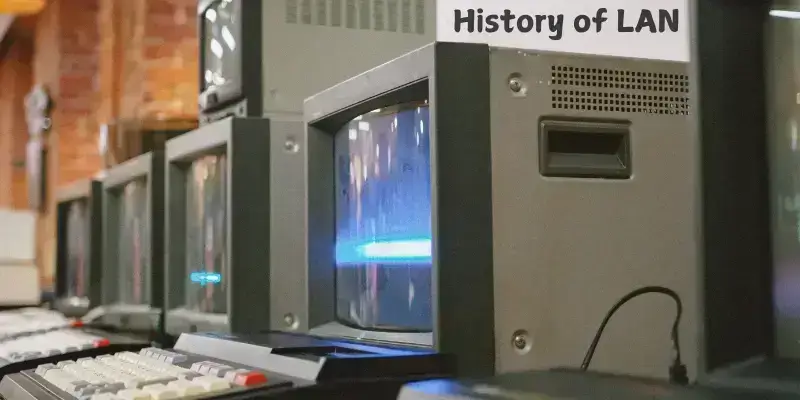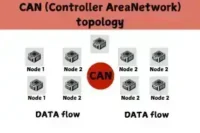History of LAN (Local Area Network)
Published: February 5, 2025
Have you ever wondered how multiple computers in an office or home can communicate with each other seamlessly, sharing files and resources instantly? The history of LAN holds the key to understanding how Local Area Networks evolved from simple experiments to the backbone of modern digital communication. But how did all this start, and why did it become such an essential part of our daily lives? Let’s learn how it makes it more manageable for us.

1. Early Networking Concepts (Before LANs)
Before LANs existed, computers worked alone and didn’t communicate with each other. People started thinking about how to connect computers to share information. Early systems used big and expensive computers called mainframes, which governments or large companies mostly used.
The Rise of Computers in the 1950s-60s
In the 1950s and 60s, computers were very big and expensive. They could do complicated math problems but were not designed for personal use. People had to send their work to the computer and wait for the results.
Mainframes and Time-Sharing Systems
Since these big computers were costly, companies wanted to use them as much as possible. It led to time-sharing systems, allowing several people to use the same computer simultaneously.
Why Connecting Computers Became Important
As computers became more useful, they needed to share resources (like printers), provide remote access to powerful machines, and exchange data faster, especially for businesses and military needs. This idea of connecting computers would eventually lead to the creation of LANs.
2. The Birth of LANs (1970s)
In the 1970s, Local Area Networks (LANs) started to form. People began experimenting with connecting computers within a small area, such as an office or school.
First Experimental LANs
These early LANs allowed computers to share resources like printers, marking a shift from isolated computers to connected systems.
ALOHAnet (1970)
Researchers at the University of Hawaii developed ALOHAnet, a system that used radio frequencies to connect computers. It introduced the idea of random access, where computers sometimes sent data when available, even if messages were lost. This system influenced later LAN technologies.
Ethernet by Robert Metcalfe (1973)
Ethernet, developed by Robert Metcalfe at Xerox PARC, used coaxial cables to connect computers. It became a huge success, allowing multiple computers to share data efficiently, and this was the beginning of modern LANs.
IBM’s Token Ring
In the mid-1970s, IBM introduced the Token Ring, which allowed only the computer holding a special “token” to send data, preventing confusion. However, it was expensive and eventually replaced by Ethernet.
3. The Rise of Ethernet in the 1980s
In the 1980s, Ethernet became more popular and became the standard for LANs.
Standardization of Ethernet (1983)
In 1983, IEEE officially made Ethernet a standard, which made it easier for different types of computers and devices to work together.
Growth of Commercial LANs
Ethernet’s success helped businesses connect computers within their offices, allowing them to share resources and work together more easily.
Coaxial Cables and Early LAN Protocols
At first, Ethernet used coaxial cables to connect computers. The early systems had a bus topology setup, with all devices connected to a single cable.
Novell NetWare and Early Networking Software
Businesses use Novell NetWare software to manage their Ethernet networks, making sharing files and printers in offices easier.
4. LAN Expansion and Mainstream Adoption (1990s)
In the 1990s, LANs grew rapidly as the Internet became more popular.
Switch to Twisted-Pair Ethernet
Ethernet switched from using coaxial cables to twisted-pair cables (like Cat5), which were cheaper and easier to install. It made Ethernet networks more affordable for everyone.
Growth of TCP/IP and Internet Influence on LANs
With the rise of the Internet, computers started using the TCP/IP protocol to connect. This protocol helped LANs connect to the wider world, changing how businesses and people communicate.
Introduction of Wi-Fi (1997)
In 1997, Wi-Fi was introduced, allowing people to connect to networks without wires. It made LANs more flexible and mobile, especially in homes and offices.
The Impact of Windows Networking
The 1990s also saw the release of Windows NT, which made managing LANs easier, and peer-to-peer networks allowed smaller businesses to connect computers without a central server.
5. The Evolution of LAN in the 2000s
In the 2000s, LANs adapted to handle faster speeds and more devices.
Gigabit Ethernet
Ethernet became faster with Gigabit Ethernet (1 Gbps), which allowed businesses to handle more data and work faster.
Switches Replace Hubs
Switches replaced hubs because they directed data to the correct computer, improving network speed and performance.
Enterprise LAN Expansion and VLANs
Large companies have started using VLANs (Virtual LANs) to organize better and manage their networks.
Security Improvements
As more businesses connected to the Internet, security became a priority. LANs added firewalls and VPNs to protect data.
6. Modern LANs (2010s – Present)
Today, LANs have become faster, more flexible, and connected to the cloud.
Wi-Fi 6 and Fiber-Optic LANs
Wi-Fi 6 and fiber-optic cables offer faster speeds and support for more devices, making LANs even more powerful.
Software-Defined Networking (SDN)
Software-defined networking (SDN) allows businesses to manage their networks with software, making them more adaptable and easier to control.
Cloud-Based Networking
Many businesses now use a mix of local LANs and cloud computing to store data and run programs, making it easier to scale up their networks.
Integration of IoT and Smart Devices
With more smart devices (like cameras and sensors) connecting to LANs, networks have become more complex. To manage everything, new technology and better security are required.
Conclusion
LANs have evolved from simple systems in the 1970s to the essential networks of today, supporting high-speed connections and smart devices. LANs will remain vital, powering IoT, cloud computing, and faster data transfer with Wi-Fi 6 and SDN technologies. LANs are crucial for modern connectivity. As the digital world expands, they will remain at the core of personal and business networks. Explore LANs further and stay ahead in the fast-evolving world of digital connectivity!
Be cautious of poor network security and mismanagement—ensure your LAN is secure and properly configured.
FAQs About History of LAN (Local Area Network)
A Local Area Network (LAN) connects computers and devices within a small area, such as a home, office, or school. It began in the early 1970s with experiments to link computers nearby, and Ethernet became one of the first successful LAN technologies.
Before LANs, computers worked independently without sharing resources like printers or files. Researchers realized that connecting multiple devices would improve efficiency and make resource-sharing easier.
ALOHA was the first notable LAN technology developed at the University of Hawaii in 1970. It used radio frequencies to link computers, allowing them to share information over a small area, laying the groundwork for future LANs.
Ethernet, invented by Robert Metcalfe in 1973, revolutionized LANs by allowing multiple computers to share a single coaxial cable. Due to its speed and efficiency, it became the standard for connecting devices in a local area.
Token Ring, developed by IBM, was a competing LAN technology. Unlike Ethernet, which used a “listen and transmit” method, Token Ring used a rotating token that allowed one computer to transmit data at a time, reducing collisions.
Ethernet became more popular because it was cheaper for most applications to implement and maintain a star. I, and simpler in sign ma. This made it more adaptable to growing networks.
With the introduction of Fast Ethernet in the 1990s, Ethernet speed increased from 10Mbps to 100Mbps. This boost in speed helped LANs handle the growing number of connected devices and allowed businesses to adopt LANs more widely.
Wi-Fi, introduced in 1997, allowed devices to connect to LANs wirelessly, removing the need for physical cables. This change made LANs more flexible and convenient, especially for mobile devices like laptops and smartphones.
The history of LANs paved the way for modern networking technologies like Wi-Fi, cloud computing, and fiber-optic connections. The core concepts of LANs—connecting devices locally—are still foundational in today’s networks.
The future of LAN technology includes faster speeds like 10G Ethernet, wireless LANs like Wi-Fi 6, and the integration of smart devices. As technology advances, LANs will evolve, making networking even more efficient and accessible.





